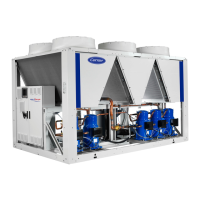17
Electronic Expansion Valves (EXV) — All
30MP050-071 units are equipped from the factory with EXVs.
The 30MPA and 30MPW units with medium brine tem-
perature brine also have the EXV set at the factory to maintain
9°F (5° C) suction superheat leaving the cooler by metering the
proper amount of refrigerant into the cooler.
The EXV is designed to limit the cooler saturated suction
temperature to 50 F (12.8 C). This makes it possible for the unit
to start at high cooler fluid temperatures without overloading
the compressor.
Capacity Control — Capacity control is determined by
the difference between the leaving fluid temperature and the
Control Point (Run Status
VIEW
CTPT) and its rate of
change. The Control Point (CTPT) is the current set point mod-
ified by a temperature reset command. This can be from the
temperature reset function or the dual chiller routine. The ca-
pacity control routine runs every 30 seconds. The algorithm at-
tempts to maintain the Control Point at the desired set point.
Additionally, the control calculates a rise per stage knowing
which compressor is on, its capacity and the temperature differ-
ence across the cooler (entering fluid temperature minus leav-
ing fluid temperature) to determine the best time to turn on or
off the next compressor, institute Minimum Load Control, or
change the digital response, if equipped. Entering and Leaving
fluid temperatures can be monitored at the unit's interface de-
vice Run Status
VIEW
EWT and Run Status
VIEW
LWT. With this information, a capacity ratio is calculated to de-
termine whether to make any changes to the current stage of
capacity. This ratio, Capacity Load/Unload Factor (Run Sta-
tus
VIEW
LOD.F) value ranges from –100% to +100%
times Deadband Multiplier (Configuration
SLCT
Z.GN).
See Deadband Multiplier on this page for more information. If
the next stage of capacity is a compressor, the control starts
(stops) a compressor when the ratio reaches +100% (–100%)
times Deadband Multiplier (Z.GN). Once a change in capacity
occurs, a 90-second time delay is initiated and the capacity
stage is held during this time delay.
When the unit is at stage zero (Requested Stage Run Sta-
tus
VIEW
STGE=0) as part of the capacity control routine,
the control adds a 1.2 factor on adding the first stage to reduce
cycling.
If the unit is equipped with a digital compressor, it is nor-
mally the first compressor started. If the lead compressor is a
digital compressor, and is enabled and available (not in alarm),
the compressor will start fully loaded for 90 seconds prior to
starting to cycle between loaded and unloaded. Once the digital
compressor is on, positive changes in LOD.F will cause the
compressor to load. Negative changes to LOD.F will cause the
compressor to unload. This process can occur every 30 sec-
onds. Changes to the digital loading are not subject to the 90-
second delay. See Digital Scroll Option on page 36 for addi-
tional information.
If the unit is equipped with Minimum Load Control, it will
not be active until the unit is on its last stage of capacity. It too
is treated as a stage of compression. As a result, Minimum
Load Control will be activated when capacity is decreasing,
Requested Stage STGE=1, and Capacity Load/Unload Factor
LOD.F= -100% times Deadband Multiplier (Z.GN). See Table
14 for capacity step information.
MINUTES LEFT FOR START — This value is displayed
only in the network display tables (using Service Tool,
ComfortVIEW™ or ComfortWORKS™ software) and
J6
6
7
RED
BLK
RED
RED
BLK
BLK
BLK
RED
BLK
RED
SENSOR 1 SENSOR 2 SENSOR 3 SENSOR 4
J6
6
7
RED
BLK
RED
BLK
SENSOR 2
SENSOR 1
RED
RED
BLK
SENSOR 3
SENSOR 4
BLK
BLK
RED
RED
RED
BLK
BLK
SENSOR 8
SENSOR 9
SENSOR 5
RED
BLK
SENSOR 6
SENSOR 7
BLK
RED
SPACE TEMPERATURE AVERAGING — 4 SENSOR APPLICATION
Fig. 12 — Space Temperature Averaging
LEGEND
Factory Wiring
Field Wiring
SPACE TEMPERATURE AVERAGING — 9 SENSOR APPLICATION

